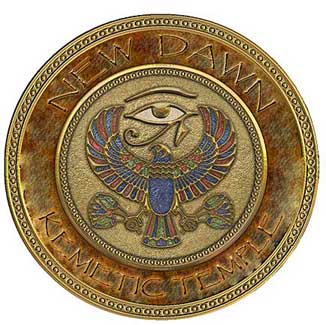|
|
|


~Mark Andrews~
Tuthmosis III built his mortuary temple just south of the entrance to Deir el-Bahri on the West Bank at Luxor. He apparently began the temple early in his reign, probably while he was still under the regency of Hatshepsut. It was most likely also built prior to his memorial related temple within the Amun temple complex at Karnak. It was called Henkhet-Ankh, or "Offering-Life". Originally excavated early in the 20th century, neither that effort, nor a later investigation provided much information about the temple complex.
We know that the enclosure walls of the temple complex were partly cut from the rock of the area and finished off with mudbrick. We believe it also contained a number of Osiride columns (pillars) and a chapel dedicated to Hathor. Interestingly, the sanctuary had a vaulted ceiling decorated with the hours of the day and night, normally found in royal tombs in the Valley of the Kings. The sanctuary also featured a false door, set in the rear wall, and dedicated in the king's name. Some investigators have also suggested that the temple had a court with an altar to the sun god.
The temple of Tuya and Nefertari basically adjoins the northern side of the main Ramesseum temple. Though an earlier chapel may have stood on this site, the more modern temple was dedicated to the mother and great royal wife of Ramesses II. Apparently the pharaoh Hakoris, who ruled during Egypt's Late Period, destroyed the temple, but enough of the ruins survived to determine the basic floor plan. It apparently had a bipartite design reflecting its dual dedication.
Just a little to the southwest of the Ramesseum, the mortuary temple of Tuthmosis IV is fronted by two pylons which opens into narrow courts and a portico. The portico has one row of pillars and another row of columns. Beyond the portico was a hypostyle court, which in turn lead to a transverse hall and then the inner sanctuary and its adjoining rooms and storage annexes.
This temple is notable because it seems to have served as a model for the temples built by Tuthmosis IV's successor, Amenhotep III. Both Amenhotep III's mortuary temple and the core area of the Luxor Temple both appear to follow the general design of Tuthmosis IV's temple.
The temple of Wadjmose is a very small temple located between the Ramesseum and the temple of Tuthmosis IV. It was a temple built during the 18th dynasty. Wadjmose was a son of Tuthmosis I. However, some Egyptologists, and notably Stephen Quirke, have suggested that the structure may actually have been built by Tuthmosis I himself. Though a few blocks, stele and fragments of statues have been found at this site, little else is known about the history of this temple.
The temple of Siptah and Tausert ( Tawasret) lies between the temple of Tuthmosis IV and the mortuary temple of Merenptah. It is completely destroyed, and hardly anything is known of the structure. Almost nothing has been found at this site, with the exception of a few jar fragments and small stone faience plaques.